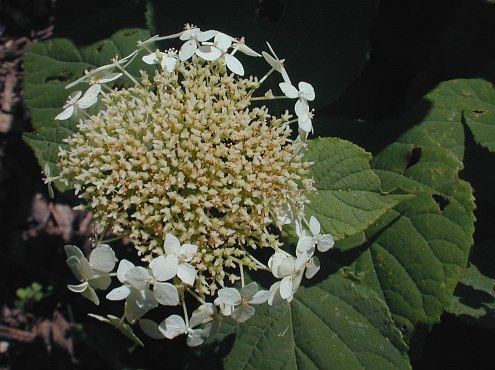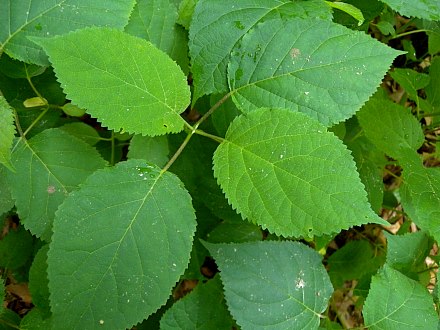Description: This shrub is 3-8' tall, producing unbranched canes that are erect. Young tips of the central cane are light green and sometimes pubescent, otherwise the cane is woody with gray to brown bark. With age, this bark tears off into multicolored sheets, providing it with a tattered appearance. Pairs of opposite leaves occur at intervals along each cane. These leaves are about 4-6" long and 3-5" across; they are oval-ovate or oval-cordate and serrated along their margins. The upper surface of each leaf is medium to dark green and hairless, while the lower surface is pale green and either hairless or sparsely pubescent. The slender petioles are 2-6" long and either hairless or pubescent.

Each cane
terminates in a flat-headed panicle (or compound cyme) of flowers about
3-6" across. In the center of the panicle, there are numerous fertile
flowers that are very small in size, while around the outer margin of
the panicle there are a few sterile flowers that are larger in size
(about ¾" across). However, sterile flowers are occasionally absent in
some populations of wild plants. Each fertile flower has a short light
green calyx with insignificant teeth, 5 tiny white petals less than
1/8" (3 mm.) long, 8 or 10 stamens with long filaments, and a pistil
with a
pair of styles. The fertile flowers are either greenish white or
cream-colored. Each sterile flower has 3-4 petaloid bracts that are
large and white. The branches of the panicle are dull cream-colored and
usually pubescent. The blooming period occurs from early to mid-summer.
The fertile flowers are in bloom for only a short time, while
the
sterile flowers remain attractive until the autumn. Each fertile flower
is replaced by a small 2-celled
seed capsule about 1/8" (3 mm.) across that has a pair of tiny curved
horns on
its upper surface. The sides of the capsule are ribbed. Each capsule
contains many tiny seeds that are flattened; they are small enough to
be blown about by the wind or carried by currents of water. The root
system can develop clonal offsets from underground runners. As a
result, colonies of plants are often formed.
Cultivation:
The preference is dappled sunlight to light shade, consistently damp
conditions, and a moderately acidic to neutral soil that contains some
decaying organic matter. To prevent a straggly appearance, this shrub
can be cut back during the autumn. A humid area with some protection
from
the wind is desirable.
Range & Habitat:
The native Wild Hydrangea is occasional to locally common in southern
Illinois,
uncommon in central Illinois, and largely absent from the northern
section of the state. Habitats include shaded ravines, rocky stream
banks in wooded areas, bottoms of bluffs and cliffs, low rocky ledges,
and similar habitats in wooded areas. Wild Hydrangea is found in high
quality natural areas. It is also cultivated in gardens.
Faunal Associations:
The fertile flowers offer nectar and pollen to a wide range of visiting
insects. These visitors include bumblebees, little carpenter bees
(Ceratina spp.), Halictid bees, masked bees (Hylaeus spp.),
miscellaneous wasps, mosquitoes, Syrphid flies, thick-headed flies,
Muscid flies, dance flies (Empis spp.), tumbling flower beetles, and
long-horned beetles. The foliage of Wild Hydrangea is eaten by the
caterpillars of Darapsa versicolor (Hydrangea
Sphinx) and Olethreutes ferriferana (Hydrangea
Leaf-Tier Moth). Some polyphagous insects occasionally feed on this
shrub; these species include the thrips Echinothrips
americanus, the seed bug Kleidocerys resedae,
the aphids Aphis rumicis and Aphis
citricola, and the larvae of the long-horned beetle Stenocorus
cinnamopterus. White-tailed Deer occasionally browse on the
canes and leaves.
Photographic Location:
The flowerhead was photographed at the Arboretum of the University of
Illinois in Urbana, Illinois. The leaves were photographed at the
Potholes in west-central Indiana.

Comments: This fast-growing shrub is very attractive. The only other native hydrangea in Illinois is Hydrangea cinerea (Southern Wild Hydrangea), which is found in the southern section of the state. This latter species differs from Wild Hydrangea by the dense gray pubescence on the undersides of its leaves; it is sometimes considered a variety of Wild Hydrangea, rather than a distinct species. There are many cultivars of Wild Hydrangea in circulation. These cultivars tend to have more sterile flowers than the wild version of this species; there are even cultivars that produce only sterile flowers. While the latter cultivars are showier, they don't provide any nectar or pollen to flower-visiting insects. From an ecological perspective, this makes them less desirable.